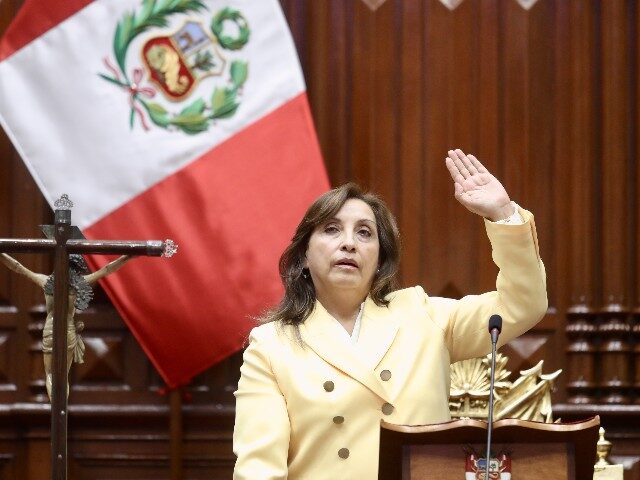Dina Boluarte became Peru’s sixth president since 2016 late on Wednesday following the impeachment and arrest of now-former President Pedro Castillo, a widely unpopular communist who had attempted to dissolve the nation’s Congress and invalidate the Constitution on the same day.
Castillo became president in July 2021 after a month-long vote counting and contesting process, allegedly defeating conservative rival Keiko Fujimori by about 0.5 percent of the vote. Fujimori – daughter of currently imprisoned former President Alberto Fujimori – accused Castillo’s communist Free Peru party of extensive fraud, but her claims did not result in any changes to the election results.
Free Peru is a far-left political party whose political platform included praise for Russian communist Vladimir Lenin and longtime Cuban dictator Fidel Castro. Castillo had attempted to distance himself from his own party’s platform during the campaign, a move that eventually proved unnecessary as three-time failed presidential candidate Keiko Fujimori’s unpopularity ultimately decided the election.
Keiko Fujimori’s Popular Force party retained control of Congress, however, and was on its third attempt to impeach Castillo on Wednesday when he attempted to dissolve the institution and impose a national curfew. Popular Force had, throughout the past year, received growing support from members of other parties, including Free Peru, in its bid to remove Castillo. Free Peru had, failing two impeachment bids, began supporting a measure to shorten presidential terms, as none of the past four presidents had completed a full term in office anyway.
This time, Castillo moved to dissolve Congress – effectively attempting to annul the results of the latest round of legislative elections – shortly before lawmakers had planned to vote on ousting him from office. The Peruvian Constitution allows Congress to very easily impeach and remove a president for almost no reason. Lawmakers can choose to remove a president if Congress agrees that he or she is suffering from “permanent moral incapacity,” a term the Constitution does not define. The Constitution also specifically identifies “dissolving Congress” as a valid reason for impeachment.
On Wednesday afternoon, prior to his third impeachment vote, Castillo issued a national address in which he announced that he had ordered Congress to no longer exist.
“[I issued an order] to dissolve temporarily the Congress of the Republic and install an emergency government,” Castillo announced, “to convene as soon as possible elections for a new Congress with constitutional faculties to draft a new constitution in a time spanning no more than nine months.”
Castillo also announced that he would dissolve the entire judiciary, effectively firing the nation’s judges, the attorney general, and all judiciary officials.
“From now on and until a new Congress of the Republic is installed,” Castillo announced, “governing will happen through executive orders”:
Neither the nation’s military nor its police went along with the declaration, and, rather than executing Castillo’s wishes and imposing a curfew, they arrested him. Castillo and his family appeared to attempt to flee the presidential palace shortly before he was placed in police custody:
🔴 #LOÚLTIMO | Pedro Castillo sale de Palacio de Gobierno tras golpe de Estado 👉🏼 https://t.co/S5IJmmIE4j#LatinaNoticias pic.twitter.com/lxjtxQ5x8a
— Latina Noticias (@Latina_Noticias) December 7, 2022
Peru’s attorney general, Patricia Benavides, issued a statement announcing that Castillo had attempted to violate the separation of powers and flaunt the Constitution, resulting in legal action.
“We condemn the rupture of the constitutional order,” the statement, on behalf of the nation’s prosecutors, read. “The constitution of Peru enshrines separation of powers and establishes that Peru is a democratic and sovereign republic … no authority can put itself above the constitution and should comply with its constitutional mandates.”
The Peruvian armed forces and the national police of Peru also published a joint statement condemning Castillo and ensuring the public they would not execute his commands.
“Any act contrary to the established constitutional order constitutes a violation of the constitution and results in no recognition on the part of the Armed Forces and National Police of Peru,” the statement read in part. “We request that citizens remain calm and trust in the legally established state institutions.”
Police arrested Castillo, with the judiciary’s blessing, on Wednesday evening, and transferred him to the same prison currently housing 84-year-old Alberto Fujimori. Fujimori is currently serving a 25-year sentence for alleged human rights violations committed during his tenure in power.
Like Castillo, Fujimori also famously dissolved Congress and the judiciary in a bid to stay in power in 1992, a move Peruvians often refer to as autogolpe (“self-coup”) or Fujimorazo. While the elder Fujimori remained in power through 2000, Castillo did not make it through the day. He is currently under police custody in the same prison housing Fujimori.
The facility also once housed another former president, the leftist Ollanta Humala, who served a short sentence after being convicted of corruption charges. Alberto Fujimori reportedly welcomed the fellow head of state with homemade sandwiches. Like Castillo, Humala became president by defeating Keiko Fujimori.
Boluarte, the now-former vice president, campaigned alongside Castillo with an equally radical message.
“This pandemic that is overwhelming the world and overwhelming our country, since we have an inefficient health [system] and a state incapable of prioritizing health, the comfortable Lima middle class will surely cease to be a comfortable middle class,” Boluarte said in April 2021, in an apparent warning to Fujimori’s voter base.
While Reuters identified Boluarte as Peru’s first female president, another former vice president, Mercedes Aráoz, served as president between September and October 2019, during another constitutional crisis in which Congress attempted to oust Martín Vizcarra. Vizcarra supporters do not recognize Aráoz as having served legally in an “acting” presidential role.
Vizcarra became president after Pedro Pablo Kuczynski, who defeated Keiko Fujimori in the 2016 election, resigned after Keiko Fujimori’s party published a video showing Kuczynski staffers apparently discussing a vote-buying scheme with her brother, Congressman Kenji Fujimori.
Follow Frances Martel on Facebook and Twitter.

COMMENTS
Please let us know if you're having issues with commenting.